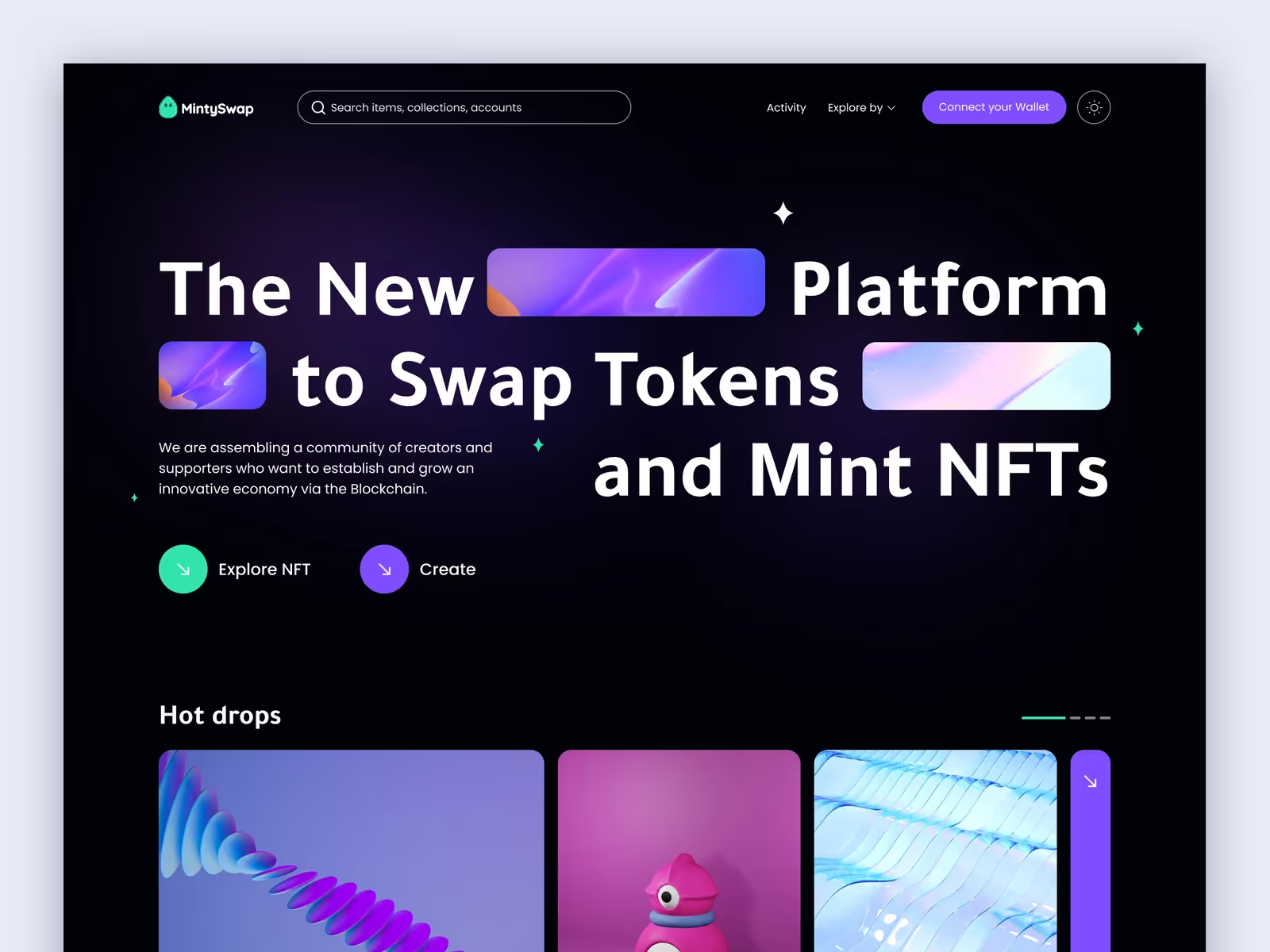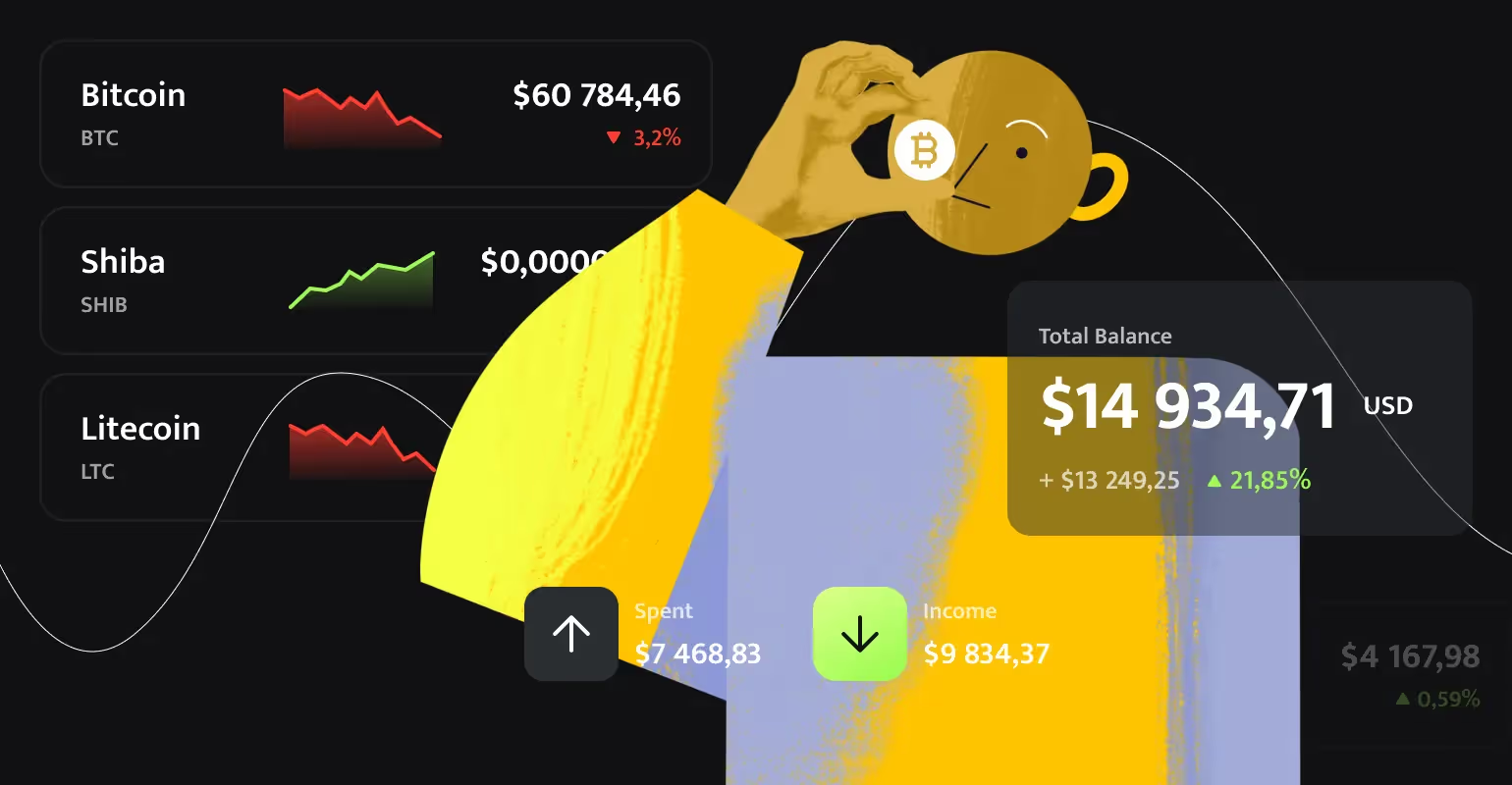If you are ready to enhance your web design with expert solutions, let’s talk!
DeFi apps are going mainstream. People discover ways to monetize nearly everything. They trade, mint, swap, fund - and earn money. No wonder you are looking for information on how to develop a DeFi app and join the blossoming blockchain economy. The question is how to create a financial application to generate robust traction and stay viable.
The Arounda team has been in your shoes while developing a UX/UI for the MintySwap NFT marketplace. We consumed all possible educational materials, tried out different crypto wallets, and went through the entire process of creating a non-fungible token. But the experience we gained is worth the effort. And here, we share the basics of how to build a DeFi app. We will also provide five essential tips in this regard.
What are DeFi Apps?
DeFi stands for DEcentralized FInance. These applications run on blockchain technology and allow for trading currencies, tokens, stocks, and other digital assets. DeFi Apps are similar to traditional banking applications because they provide some regular financial functions. Users can borrow, earn, speculate, raise funds, and more.
You may wonder what the whole buzz is about. The core distinction of DeFi Apps is in the blockchain nature. Users don’t share their private information with banks or any other third party because the crypto network is decentralized. Instead, peer-to-peer transactions occur based on smart contracts secured by cryptography algorithms.
Types of DeFi Apps
You can utilize numerous services with decentralized finance applications. So let’s get down into the details and reveal some DeFinitions!
DeFi Banking
DeFi banking is an alternative to the current financial system. And this market is snowballing. The most attractive benefits are the speed of transactions, complete control of your money, product transparency, and the market’s constant development.
NFT

NFTs (non-fungible tokens) can represent anything you own, such as digital art, in-game items, articles, tickets, domains, or videos. Can you imagine a virtual fashion item that costs $26,000? Well, that was the price of the first NFT-linked hoodie by Overpriced.™.
Borrowing / Lending
Like lending money from the bank when taking credit, lending crypto allows acquiring the needed sum in cryptocurrency. You can perform it in a few minutes in return for regular interest payments.
Wallets
A crypto wallet is the only thing that DeFines your identity on the blockchain network. You can think of a wallet as a banking app that works without a bank. With such a wallet, you can track your balance, make transactions, and interact with platforms like Ethereum or EOS.
Decentralized Crypto Exchanges (DEX
Popular centralized exchanges like Coinbase and Gemini give way to DEX (decentralized exchanges) with peer-to-peer transactions. The revolutionary UniSwap V3 protocol has facilitated nearly $28 billion in volume within weeks of its launch.
DeFi Crowdfunding Platforms
Crowdfunding on a blockchain basis has the same principles as traditional crowdfunding. But it offers some unique benefits for recipients and donors. Recipients access a greater pool of donors worldwide. Meanwhile, donors win by converting a cryptocurrency donation into a tax contribution.
DAOs
Decentralized autonomous organizations (DAOs) are self-governed communities with a shared mission but without centralized leadership. Members holding DAO tokens like ERC20 can vote for the project development.
Steps to Develop a DeFi App

Now, let’s get down to business and outline how to create a DeFi project. Of course, you will require both marketing and technology essentials for a complex task like that. But don’t worry. We will guide you through this process step by step.
Choose the DeFi apps' type
First, you should define what features you want to implement. For that, try to answer the following questions:
- Who will use the app?
- Why should customers prefer your solution?
- What are the unique benefits and limitations of your product?
Take your time for a discovery phase
Now that you know the essential functions and peculiarities of your DeFi app, it’s wise to investigate if it fits the market. In particular, it’s a good idea to study your competitors:
- Do they offer to import NFTs or connect to the MakerDAO platform?
- How do your competitors distribute tokens through the network?
Choose blockchain
Now, let’s move from product design to technology challenges. The decision on blockchain will influence the other choices on protocols, wallets, etc. You have probably heard that Ethereum is the largest platform. But this popularity has its price. The more traders use Ethereum, the lower the transaction speed and the higher the fee.
So before joining the most prominent crypto community, remember that a simple transaction may cost $60-120 in network fees. When you search for options on how to create a DeFi app, remember that many major blockchains like Terra, TRON, or Binance Smart Chain support smart contracts, too.
Define tokenomics
Most dedicated DeFi apps create new tokens with unique value on the market. Tokenomics is the mechanism that defines how your token works:
- Does it allow exchanging, staking, or donating to a liquidity pool?
- Will your token give users voting rights or awards?
- Will it be a stablecoin with low volatility and inflationary pressure or not?
All these details will regulate the smart contracts, define their cash flow, and determine your income on the token you want to sell.
Integrate a crypto wallet
Since all blockchain users have crypto wallets, you should define how they will connect to your financial app. The most usual practice is to include operations through existing wallets, like MetaMask or Trust Wallet, into your app. Don’t worry - it’s easier than it sounds. APIs and SDK tools help both savvy programmers and non-technical developers with this task.
On the other hand, you can choose a more ambitious alternative and introduce your own crypto wallet with private keys. In this case, you will need the Everchain tool that supports multiple coins and tokens.
Plug to oracles
Successful DeFi apps provide data about events happening in the crypto world through third-party agents called oracles. You can plug in through their API endpoints and distribute the essential information to your users. Note that most oracles charge fees for their data.
Polish UI/UX design
The blockchain decentralized network itself is a challenge. An app shouldn’t overwhelm newbies with the interface. Thus, when you decide how to build a DeFi app with a human-centric UI/UX design, prioritize the simplicity rule.
Don't skip prototyping
It all starts with an excellent idea. But the sooner you test your vision on an MVP, the earlier you adjust your product to market demands. Prototypes provide a huge economy of time and money for the whole PLC (Product Life Cycle). So don’t hesitate to show the world what you’ve got at the earliest stages of your project.
Essure Quality
DeFi apps multiply en masse, but not all deliver reliable quality. The best way to stand out from the crowd is to ensure your app will be bug- and error-free. It should work stably under different OSs, including smartphones and PCs.
Support and Maintain
Your app is going to evolve along with the blockchain ecosystem changes. It depends mainly on the tech stack and up-to-date maintenance. For example, you can write smart contracts using the tried-and-true Solidity programming language.
Тор 5 Tips on How to Make a DeFi app
Wrapping it all up, if we look closely at any decentralized finance application and its anatomy, we’ll discover the top 5 essentials of creating one:
1. Choose a blockchain regarding its spread, transaction speed and cost, and technology stack.
2. Be precise with your tokenomics. It’s the basis of smart contracts.
3. Provide easy and intuitive UI/UX design.
4. Connect to trustworthy crypto wallets or develop your own.
5. Think of scalability and maintenance at the very beginning of your project.
Conclusion
Building a robust DeFi App depends on your team’s technology, design, and marketing expertise. Arounda product agency has been in product design for more than five years. Throughout this time, we completed various tasks, including brand identity, product strategy, and UI/UX for startups and SME clients.
So if you are looking for a partner to rely on in the blockchain environment, we are here for you.














